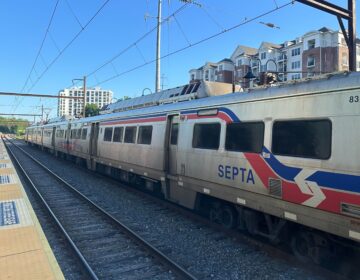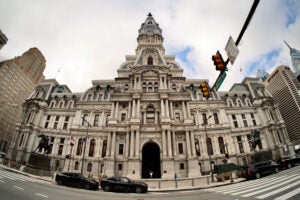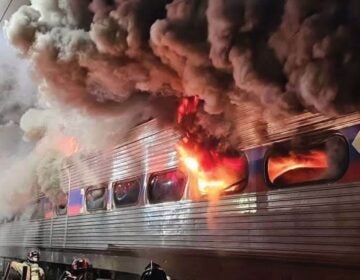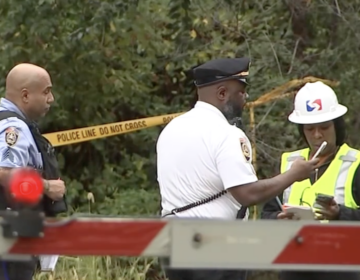Without SEPTA, Philly businesses worry about lack of parking, traffic gridlock
Service cuts could add 275,000 more vehicles to the road, and business leaders are concerned about congestion and lack of parking for commuters.
Listen 1:00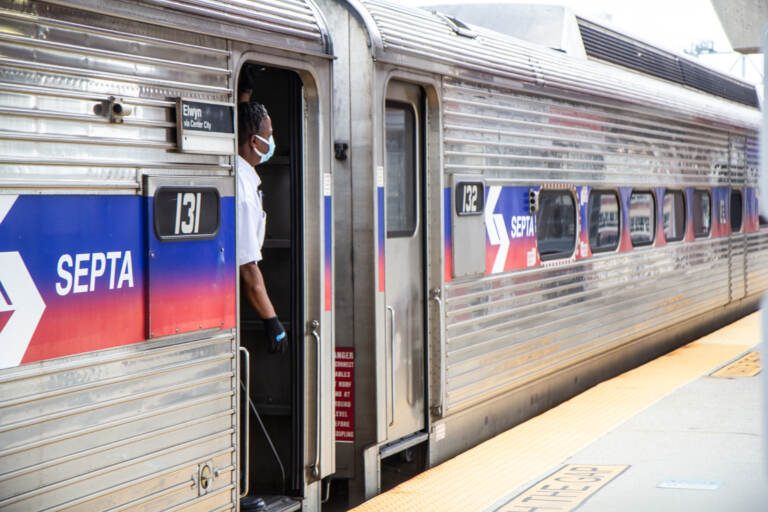
A SEPTA Regional Rail train headed to Center City, Philadelphia. (Kimberly Paynter/WHYY)
Have a question about Philly’s neighborhoods or the systems that shape them? PlanPhilly reporters want to hear from you! Ask us a question or send us a story idea you think we should cover.
As many as 9,000 University of Pennsylvania Health System employees use SEPTA to get to work during an average work week.
That includes Penn Medicine’s CEO, Kevin Mahoney, who uses Regional Rail about half the time to get to his office in University City.
Mahoney said it would be devastating for the hospital system’s patients and employees if the transit agency moves forward with significant service cuts. SEPTA is facing a structural deficit of $213 million in its 2026 fiscal budget since COVID-19 era federal relief funding has expired.
“This ranks in the top two or three things that keep me up at night,” Mahoney said. “Just the sheer number of our employees that use the Regional [Rail], trolley and bus.”
Business leaders say they worry about the regional economy if there are deep cuts to public transportation, which could lead to massive traffic congestion during rush hour for commuters. SEPTA is also an economic driver and spends about $228 million with businesses across Pennsylvania. But some Republican lawmakers say that’s not enough to offset how much taxpayers already chip in to subsidize the transit system that doesn’t operate in their communities.
SEPTA is proposing a 20% fare increase while eliminating 50 bus routes, five regional rail lines and imposing a curfew of 9 p.m. for metro and regional rail, in addition to a 20% reduction of service across its entire network in 2025 and 2026.
“Imagine how clogged up the roads would be and the impact on their ability to get to and from work if we didn’t have SEPTA,” said Chellie Cameron, president and CEO of the Chamber of Greater Philadelphia.
The chamber’s primary lobbying focus is to convince state lawmakers to make a deal for public transportation.
Cameron said there’s strong support from businesses that rely on public transit to get their employees to work every day.
About 100,000 people commute into Center City each weekday, according the Center City District. A 2020 survey found there were about 45,800 parking spaces in the busy neighborhood.
“There aren’t enough spaces in the city for people to park their cars,” she said.
Not enough commuter parking
For big employers like Penn Medicine, there’s already a dearth of parking spots for employees and patients.
There are about 11,500 parking spaces across all University City neighborhoods, according to a 2023 survey, which is not enough for daily visitors, residents and commuters if there was no public transportation option.
Penn Medicine has supported the public transportation network in recent years.
In 2020, Penn Medicine inked a five-year deal with SEPTA worth $3.3 million for the naming rights of the University City Station Regional Rail stop to become Penn Medicine Station.
In 2022, the health system purchased thousands of public transit passes through the SEPTA Key Advantage, a program used for employers to buy key cards in bulk.
Penn Medicine also offers about 4,500 free SEPTA passes for eligible low-income patients. Many older adults or disabled individuals rely on SEPTA Access, a door-to-door service for medical visits as well.
Mahoney said he’s not confident SEPTA will secure more state subsidies to avoid the cuts, but he’s still pushing for a permanent transit funding deal.
“There’s so many pressure points on the state budget,” Mahoney said, like public education and pending federal cuts to Medicaid spending. “It’s not like we’re trying to balance one thing.”
In the meantime, it’s working on alternatives such as private shuttles like its Penn Transit buses to pick up and drop off workers at its stadium parking lot or even rental parking lots.
“We’d have to work it out. We’re trying to think through our contingency plans,” Mahoney said.
As business chamber members consider how they might sway Republican lawmakers in Pennsylvania, Mahoney said that Penn is increasingly active across the state.
“As we’ve become more integrated across the state, a central Pennsylvania legislator might not see [the health of Penn] as important, but Lancaster General is part of Penn Medicine. Chester County is part of Penn Medicine. And we function as a whole,” he said.
Traffic jam fears mount
SEPTA ridership has significantly rebounded since record lows when the COVID-19 pandemic began five years ago.
In March, more than 746,500 riders used SEPTA across all modes of transportation, a 14% increase compared to March 2024.
That same month, Regional Rail served 84,800 weekday passenger trips.
Many of those riders are commuters. There are about 20,000 people who work at the Philadelphia International Airport but there are only 3,700 employee parking spots. Meaning, about one in four airport workers use public transit for night shifts.
The Delaware Valley Regional Planning Commission estimates another 275,000 vehicles will be on the road if the cuts go into effect, including delays on eastbound I-76 eastbound by 20%, according to the commission’s analysis.
Cameron, the Chamber of Greater Philadelphia CEO, said she’s confident that Pennsylvania Republicans and Democrats will be able to hash out a bipartisan transportation funding plan this year for a permanent funding plan.
“Better roads, better bridges for their folks could be a way when combined with transit funding for everybody to find a win,” she said. “But I think we have to continue to emphasize the disproportionate share of the Commonwealth’s economy that comes from southeastern Pennsylvania.”
Is SEPTA getting its fair share?
And that’s something state Rep. Jesse Topper, R-Bedford, agrees.
“Any major city needs mass transit and any successful state needs their major cities to be successful. It’s part of the ecosystem of our economy. I understand how important the Philadelphia region is to Pennsylvania on a whole,” Topper said.
For example, SEPTA contracts with businesses across most of the state, on average $228 million each year.
That includes $29.8 million for Harrisburg-based United Concordia Companies Inc., a dental plan provider; $34 million with Easton Coach Company for suburban paratransit services; $2 million with Leesport-based Panoptic Sourcing & Supply LLC for industrial supplies.
Topper represents Bedford and Fulton counties where procurement records show about $1,000 worth of SEPTA contracting in those communities between 2019 and 2023.
SEPTA is already subsidized by taxpayers on the federal, state and local level for its operations in a budget that runs from July 1 through June 30.
During fiscal year 2023, SEPTA budgeted $432 million in federal, $757 million in state and $108 million in local subsidies totaling $1.2 billion.
In Pennsylvania, the state funding stems from a portion of sales taxes that sit inside the Pennsylvania Public Transportation Trust Fund.
For fiscal year 2024, SEPTA budgeted $347 million from the federal government, $853 million from the state and $122 from local government for $1.3 billion in subsidies.
For fiscal year 2025, SEPTA budgeted $54 million from the federal government, $1.1 billion from the state and $167 million from local municipalities for a total of $1.3 billion in taxpayer subsidy.
For fiscal year 2026, SEPTA budgeted $55 million from the federal government, $1 billion from the state and $157 million from local government for $1.3 billion in taxpayer subsidies.
But Republicans like Topper say they’re not willing to keep filling the budget gap for SEPTA with state support.
“I don’t see a reality where we continue to fund at this level and somehow that’s going to be achievable,” he said.
Public transit privatized?
Instead, Topper plans to introduce legislation to create a public-private partnership for parts of the transit system.
“There has to be an element of public dollars. But the way the private sector would come in and evaluate what is being done and how they can do it better to create efficiencies,” he said. “I think it’s the way to stabilize the system so that people still have access to what they need.”
The Pennsylvania legislature created SEPTA in 1963 because privately owned transportation businesses were failing without public subsidy.
Pennsylvania Majority Leader Sen. Joe Pittman, R-Indiana, is a staunch critic of SEPTA.
“Given the degree of crisis they are telling us they have, this is going to require innovative solutions and creativity that goes beyond just increasing subsidies,” Pittman said. “The state taxpayer does already invest heavily into the network.”
Pittman represents Armstrong, Indiana, Jefferson and Westmoreland counties where SEPTA spent $3.7 million on contracts with companies in those communities between 2019 and 2023.
Pittman said that doesn’t sway his position and the transit agency isn’t sustainable.
“We recognize that there is a need for transit services in this commonwealth, rural, urban and suburban alike,” he said. “But we also need to understand that when we talk about the SEPTA network in particular, it does not service the entire commonwealth.”
Just last year, Gov. Josh Shapiro reallocated $153 million of federal highway project funding away from roadwork projects to help plug SEPTA’s budget gap. That move was deeply unpopular among Republicans because it diverted funding away from other communities.
Pittman said he’s interested in the concept of privatizing SEPTA – which the transit agency has pushed back against already – and wants to see more accountability.
“What we’re looking for is an understanding that SEPTA is running as efficiently as possible, that they’re making sure their network is as safe as possible, making sure riders pay their fair share and included in that is making sure they crack down on toll evasion,” he said.
The budget deadline is June 30, but lawmakers have missed that deadline before.

Get daily updates from WHYY News!
WHYY is your source for fact-based, in-depth journalism and information. As a nonprofit organization, we rely on financial support from readers like you. Please give today.



